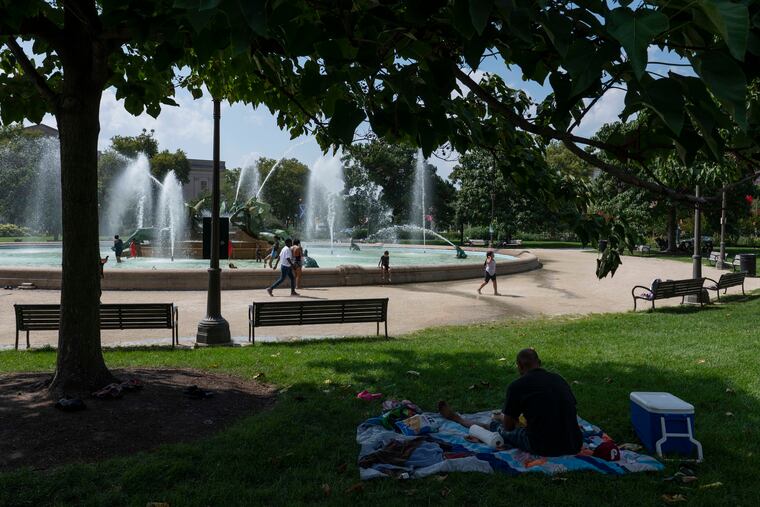Summer seasonal affective disorder is a growing problem, mental health experts say
Symptoms of the summer variant of SAD can include insomnia, hyperactivity, listlessness, and loss of appetite

For the overwhelming majority of people who live in temperate climates, Shakespeare likely distilled the essence of August when he observed, “Summer’s lease hath all too short a date.”
But some mental health experts hold that growing numbers of people would relate more to the next line in that oft-quoted sonnet: “Sometime too hot the eye of heaven shines.”
And perhaps too long.
Norman E. Rosenthal, the psychiatrist who in the 1980s first identified seasonal affective disorder, or SAD — often called the “winter blues”— says that in recent years he has seen a rise in its summer variant, which is triggered by sultriness and shorter periods of darkness that contribute to insomnia.
» READ MORE: Summers in recent years have been getting warmer in Philly
Along with sleeplessness, the symptoms include hyperactivity and loss of appetite, mental health professionals say, as opposed to the inertia and overeating associated with its cool-season counterpart. Both types can result in depression, they say, and summer SAD can be more life-threatening.
For the sufferers, summer SAD “exacerbates” the anxieties associated with otherwise ordinary worries that can compromise the pleasures of summer — the likes of paying for vacations and keeping the kids occupied — said therapist Tonya Ladipo, founder of the Ladipo Group in Philadelphia.
In some cases, said Kelly Rohan, a psychology professor at the University of Vermont who specializes in SAD research, “thinking becomes very negative, as though everything is seen through dark-colored glasses.”
For reasons that aren’t clear, both varieties are far more prevalent in women than men.
The summer version was discovered decades ago; however, it has remained largely under the radar, overshadowed by the more prevalent winter SAD, Rosenthal said.
“We looked for the winter depression, and the people with summer problems had to elbow their way in, so to speak,” said Rosenthal. “It came along as a sort of stepchild to winter.”
For a variety of reasons, the hard numbers are lacking, the experts say. “I think it’s underdiagnosed,” said Ladipo, whose practice has offices in Center City and Manayunk. As many as 10 million to 15 million adults in the United States suffer from seasonal affective disorder, and Ladipo estimates that 10% to 15% of those have the summer variant.
Said Rosenthal, “There are no good estimates,” but with rising temperatures and a general shift of the U.S. population to warmer climates, “now I see more and more people complaining of summer problems.”
Does the world really need another disorder?
Through the years, Rosenthal’s SAD concept has weathered skepticism; however, it also has had wide support in the mental health community, backed by research.
Rosenthal says the seasonal afflictions, including summer’s, are real: “It’s not all in your head. It is a reaction to an environment.”
» READ MORE: The cool-season variant is more common, but summer SAD is very real, experts say
Not everyone takes summer SAD seriously, said Ladipo. “Some people minimize it, say, ‘What’s the big deal? Why not just deal with it?’”
She said seeking treatment isn’t a sign of weakness. “I actually think it’s really strong and courageous to say, ‘Something is bothering me. ... It may not bother other people, but it bothers me.’”
Said Rosenthal, “Everybody gets bothered by the heat,” however, “some people get completely enervated. The heats strips them of their energy.”
Conversely, he said, “the light agitates people. People say, ‘I can’t get to sleep.’” Insomnia, he said, can lead to agitated or depressive states.
Patients might become “overactivated,” he said, potentially increasing suicide risks. Research has documented that suicides peak in the warm seasons, he added.
He believes that those who suffer depression in summer may be “more impulsive and capable of acting on their impulses.”
A short history of SAD
After Rosenthal left his native South Africa in the 1970s for his psychiatric residency in New York, he had a disconcerting experience during his first October in America. “I felt myself slowing down,” he has said, “being less productive.”
He deduced that it was related to the fact that the days were leaking light (Times Square and Broadway notwithstanding). The nights were lengthening rapidly with the approach of fall, and he was 1,000 miles farther from the equator than he was in his homeland, where spring was unfolding.
When Rosenthal moved on to the National Institute of Mental Health in Washington, he did landmark research on the phenomenon. He recalled poring through surveys in which respondents again and again described profound difficulties coinciding with changes in light.
In 1984, he gave it a name with that appropriate acronym SAD, which he described in his book Winter Blues.
In his latest book, Defeating Sad, scheduled to come out Tuesday, he focuses on what people can do about it. The book includes a discussion of the summer version of SAD. The clinical concepts are complex, but Rosenthal, a clinical professor of psychiatry at Georgetown University Medical School, uses jargon judiciously. That makes the text accessible to lay readers, even if they don’t know the difference between a retinal ganglion cell and a neurotransmitter.
He writes that his mission is to teach people not “how to cope with SAD, but how to soundly defeat it.”
What the experts suggest
While mental health experts advise that those who experience symptoms of seasonal depression should seek professional treatment, they also offer some common-sense tips for those who find summer particularly challenging.
» READ MORE: Summer or winter, there are things that can combat SAD
They include:
Get out and exercise as early as possible in the morning.
At night, use blackout shades in the bedroom.
Take cool showers.
And no matter how enervating conditions might be, don’t isolate. Even if it’s once a week, Ladipo said, “Make sure you are still engaging with people.”